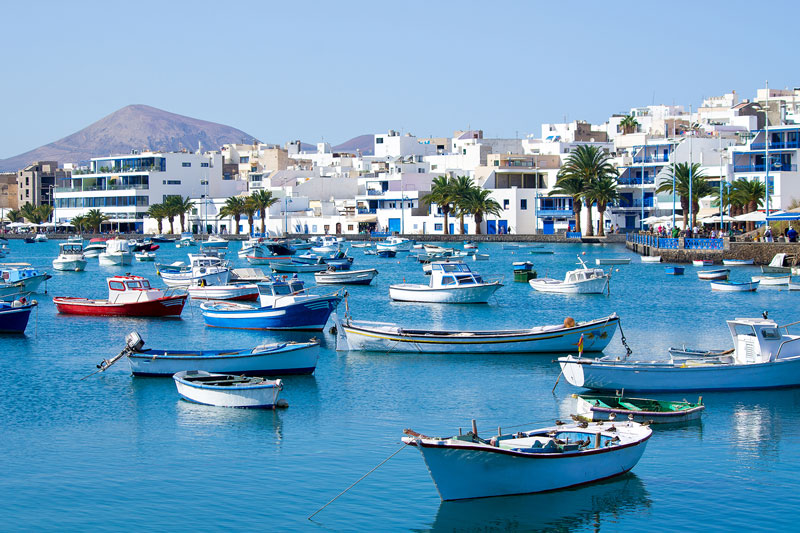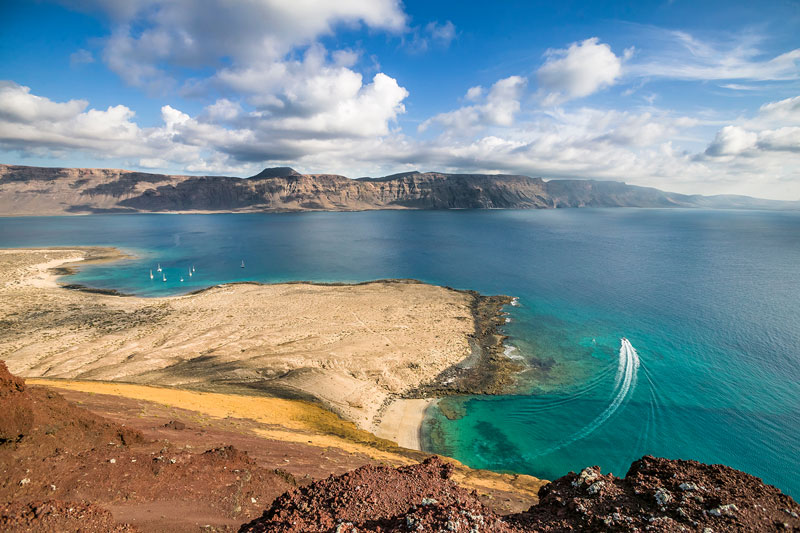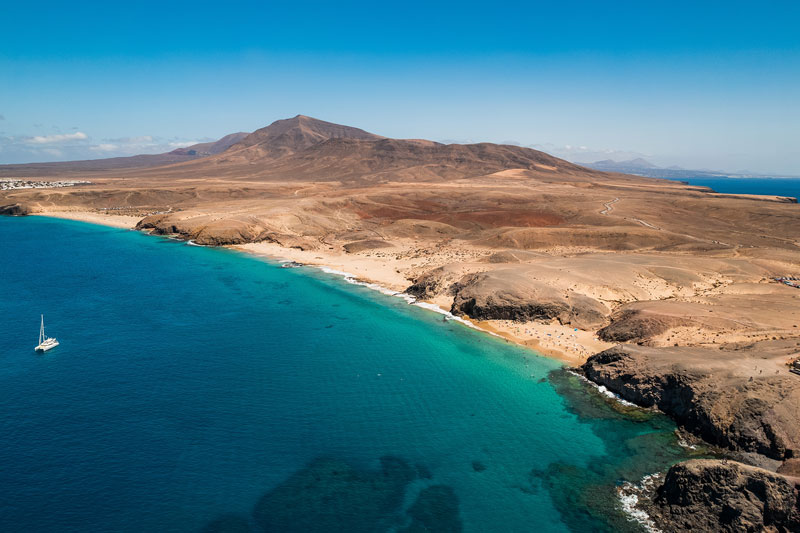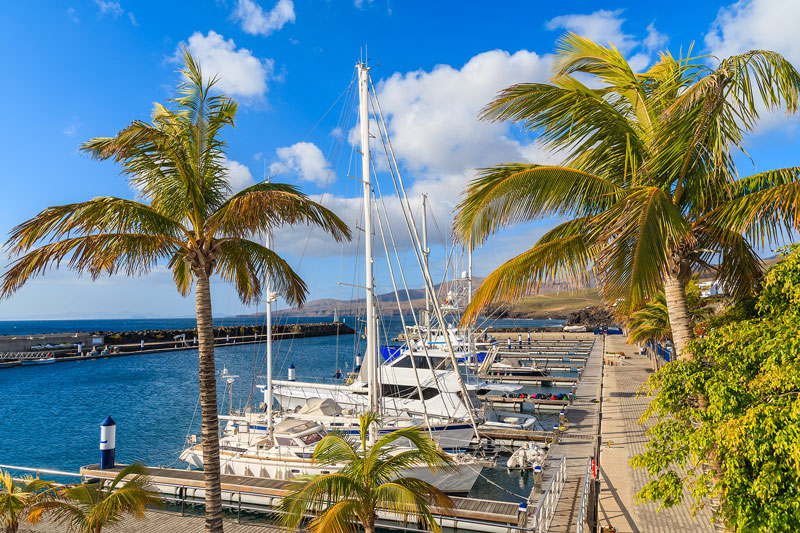Intimately intertwined with the legacy of 20th-century Lanzaroteño artist and environmentalist César Manrique, Lanzarote is an intriguing island with an utterly extraordinary geology of 300 volcanic cones, eerie blackened lava fields and the occasional bucolic, palm-filled valley.
A Unesco Geopark since 2015, the island also ticks all the good-time boxes. There are beautiful beaches (both blonde-sand and black-rock), fascinating sights, glittering natural pools and excellent hiking, cycling, surfing and diving, not to mention a wealth of restaurants and accommodation. Though long associated with package tourism, Lanzarote is now pulling in an ever-growing number of independent travellers.
Lying just 100km from the African coast, Fuerteventura recalls its neighbour Lanzarote, only with more colour. Resembling shallow piles of saffron, chilli and coriander, there are none of the mist-wreathed pines or cooling, hilly microclimates of Gran Canaria. Blown by the wind and baked by the sun, the island is truly an arresting spectacle: for the full-on, wide-angle perspective of the Martian-like landscape, climb up to the Mirador Astronómico de Sicasumbre and take it all in.
Itinerary – Lanzarote & Fuerteventura
Day 1 – Marina Rubicón
More than just a modern marina, Marina Rubicón is a place with a unique atmosphere, fashion and exclusivity. It is not hard to see the reason for the fame of this magical corner. There are beautiful and distinguished boutiques of great designers, jewelers, shoe shops, perfumeries, shops of nautical items, gifts and exclusive souvenirs made from lava. It is another example of Lanzarote’s urban construction that respects the environment, with its architectural design structured as an island village, pleasant alleys, decorated fountains, beautiful bridges and manicured gardens. A most charming atmosphere occurs on market days – twice a week the pier is filled with beautiful shops, where you will find a great variety of jewellery, handicrafts, leather goods, organic products, creams and treatments made with aloe vera.
Day 2 – Arrecife (Puerto de Naos)
Lanzarote's capital is a small, agreeable, south-coast city with a pleasant Mediterranean-style promenade, an inviting sandy beach washed by the sparkling Atlantic, and a disarming backstreet hotchpotch of sun-bleached buildings, unpretentious bars, buzzy shopping streets and restaurants of all kinds. Though a little thin on the ground for a Canarian capital, Arrecife's sights are well worth exploring, including a couple of castles, a pretty saltwater lagoon, an important art gallery and several César Manrique creations; you'll find the most historical charm in the narrow backstreets around the church and lagoon. All that said, Arrecife’s most notable quality is that it’s a no-nonsense working town that earns its living from something other than tourism.


Day 3 – La Graciosa (Caleta del Sebo)
Named the eighth Canary Island in 2018, serene sand swept La Graciosa lies just half-hour north of Lanzarote. On this low-lying beauty of an island, wild honey-gold beaches wrap around scorched volcanic cones, and the only way to explore is on foot, by bicycle or by rented jeep. Most visitors arrive on day trips from Órzola on Lanzarote, but if you stay a few nights on La Graciosa, you’ll feel worlds away from the Canary Islands’ buzz. Hike or bike over to remote Playa de las Conchas or secluded Playa Francesa before settling in for a seafood feast in low-key "capital" Caleta de Sebo. You'll enjoy excellent fresh seafood at most of Caleta de Sebo's mellow restaurants, including Casa Margucha and El Veril.
Day 4 – Costa Teguise
Framing pretty golden Playa de las Cucharas, just 8km northeast of Arrecife, the purpose-built resort of Costa Teguise is a perfectly pleasant holiday spot provided you are not expecting cobbled streets, crumbling buildings and genuine Canarian charm. Established in the 1970s, the resort inevitably lacks real soul, but the fun here revolves around bustling shopping centres, family-geared beaches and water sports, plenty of bars and restaurants (some, admittedly, more impressive than others) and the Canarian-style pueblo marinero, a fishing-village-inspired plaza area on which the great César Manrique collaborated.


Day 5 – Puerto Calero
Puerto Calero is world-famous for being one of the most prestigious destinations in sailing. It was built in 1986 and became the first marina on Lanzarote. It is an ideal location to rest with a very familiar and close atmosphere that stands out for its security, modernity and exclusivity and with its volcanic origin makes an idyllic place for an unforgettable stay. But it is not all about water - from the village there are several walking and cycling routes. These include a coastal link with Puerto del Carmen and another trail to Playa Quemada - both of which are perfect for the family. For a deeper connection with nature, there are the volcanic craters of Caldera Riscada and Montaña Tinasoria just over ten minutes’ drive inland.
Day 6 – Fuerteventura (Corralejo)
Lying just 100km from the African coast, Fuerteventura recalls its neighbour Lanzarote, only with more colour. Resembling shallow piles of saffron, chilli and coriander, there are none of the mist-wreathed pines or cooling, hilly microclimates of Gran Canaria. Blown by the wind and baked by the sun, the island is truly an arresting spectacle: for the full-on, wide-angle perspective of the Martian-like landscape, climb up to the Mirador Astronómico de Sicasumbre and take it all in. Most visitors, however, are more interested in mastering the waves and the wind than contemplating the raw aesthetics of the scenery. The second-largest island in the archipelago, Fuerteventura has year-round sunshine and the biggest and best beaches in the Canaries. The island was declared a Unesco Biosphere Reserve in 2009.

